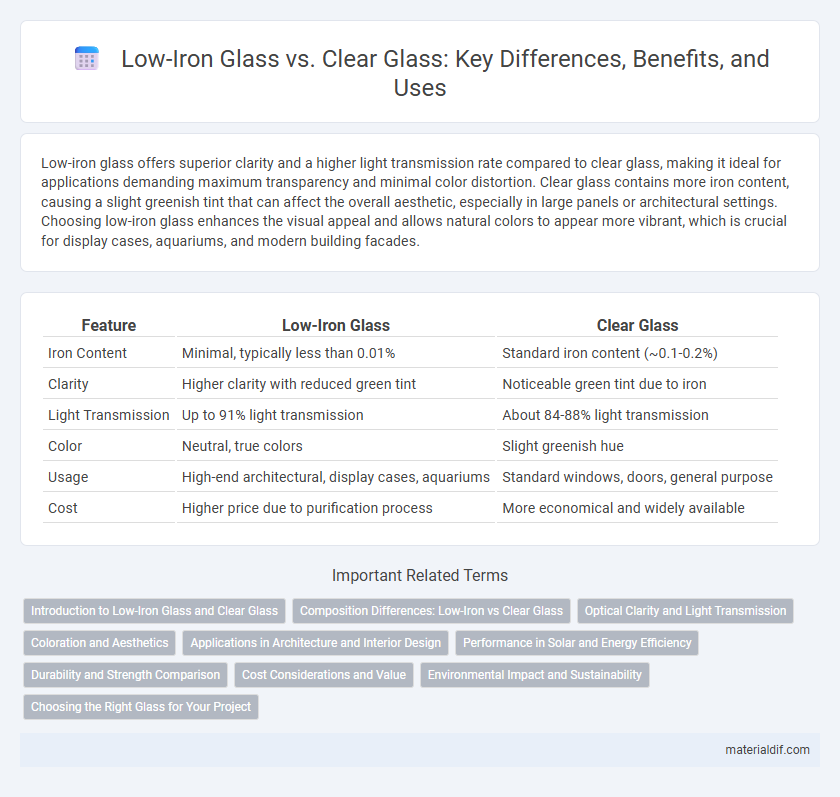Low-iron glass offers superior clarity and a higher light transmission rate compared to clear glass, making it ideal for applications demanding maximum transparency and minimal color distortion. Clear glass contains more iron content, causing a slight greenish tint that can affect the overall aesthetic, especially in large panels or architectural settings. Choosing low-iron glass enhances the visual appeal and allows natural colors to appear more vibrant, which is crucial for display cases, aquariums, and modern building facades.
Table of Comparison
| Feature | Low-Iron Glass | Clear Glass |
|---|---|---|
| Iron Content | Minimal, typically less than 0.01% | Standard iron content (~0.1-0.2%) |
| Clarity | Higher clarity with reduced green tint | Noticeable green tint due to iron |
| Light Transmission | Up to 91% light transmission | About 84-88% light transmission |
| Color | Neutral, true colors | Slight greenish hue |
| Usage | High-end architectural, display cases, aquariums | Standard windows, doors, general purpose |
| Cost | Higher price due to purification process | More economical and widely available |
Introduction to Low-Iron Glass and Clear Glass
Low-iron glass contains significantly less iron oxide than standard clear glass, resulting in higher clarity and improved light transmission with minimal greenish tint. Clear glass, also known as standard float glass, has a noticeable green tint due to iron content affecting color neutrality and visible light passage. Low-iron glass is preferred in applications requiring true color representation and maximum transparency, such as display cases and architectural glazing.
Composition Differences: Low-Iron vs Clear Glass
Low-iron glass contains significantly reduced iron oxide content, typically less than 0.03%, resulting in higher clarity and minimal greenish tint compared to clear glass, which contains standard iron levels around 0.1-0.2%. The decreased iron content in low-iron glass enhances visible light transmittance, making it ideal for applications requiring superior transparency and true color representation. Clear glass's higher iron concentration causes a subtle green hue, affecting both aesthetic quality and light transmission efficiency.
Optical Clarity and Light Transmission
Low-iron glass offers superior optical clarity compared to standard clear glass due to its reduced iron content, which minimizes the greenish tint commonly seen in clear glass. This enhanced purity allows low-iron glass to achieve light transmission rates up to 91%, significantly higher than the approximately 83-86% of regular clear glass. As a result, low-iron glass is ideal for applications requiring maximum transparency and true color representation, such as display cases, aquariums, and high-end architectural glazing.
Coloration and Aesthetics
Low-iron glass exhibits a more neutral, crystal-clear appearance compared to standard clear glass, which often has a subtle greenish tint due to iron content. This reduced iron composition minimizes color distortion, making low-iron glass preferred in applications demanding true color representation and high aesthetic quality. Architects and designers favor low-iron glass for its ability to enhance natural light transmission while maintaining a pristine, colorless look.
Applications in Architecture and Interior Design
Low-iron glass offers superior clarity and higher light transmission, making it ideal for architectural applications like skylights, facades, and glass floors where true color representation and maximum transparency are crucial. Clear glass, though more affordable, contains higher iron content that imparts a subtle green tint, often used in interior partitions, windows, and decorative elements where cost efficiency outweighs optical performance. Architects and interior designers select low-iron glass to enhance natural lighting and aesthetic appeal in high-end projects, while clear glass remains a practical choice for standard construction and budget-conscious designs.
Performance in Solar and Energy Efficiency
Low-iron glass offers superior solar performance and energy efficiency compared to standard clear glass due to its higher light transmittance and reduced green tint, allowing more natural sunlight to pass through while minimizing heat gain. This enhances daylighting and reduces reliance on artificial lighting, contributing to lower energy consumption in buildings. The improved clarity and solar control properties make low-iron glass an ideal choice for energy-efficient architectural applications aiming for optimal thermal insulation and solar heat management.
Durability and Strength Comparison
Low-iron glass offers enhanced durability compared to standard clear glass, featuring higher resistance to impact and less prone to chipping or cracking due to its refined composition with reduced iron content. Clear glass typically contains more iron, which can weaken its structural integrity and make it more susceptible to stress-induced damage under pressure or extreme weather conditions. The superior strength of low-iron glass makes it ideal for demanding architectural applications requiring both clarity and robustness.
Cost Considerations and Value
Low-iron glass typically costs 15-30% more than standard clear glass due to its higher purity and reduced iron content, which enhances clarity and light transmission. This investment delivers superior aesthetic value and is ideal for architectural and display applications where visual impact is critical. Clear glass remains a cost-effective choice for general use but lacks the color-neutral qualities that improve color accuracy and brightness in premium projects.
Environmental Impact and Sustainability
Low-iron glass offers higher solar control and energy efficiency compared to clear glass, reducing cooling costs and lowering environmental impact in buildings. Its manufacturing process typically requires less raw material refinement, contributing to decreased carbon emissions. Clear glass, while more common, has higher iron content that slightly reduces light transmission, potentially increasing energy consumption and environmental footprint.
Choosing the Right Glass for Your Project
Low-iron glass offers higher clarity and minimal green tint compared to standard clear glass, making it ideal for projects requiring true color representation and maximum light transmission, such as display cases and high-end architectural applications. Clear glass, often more cost-effective, performs well in general window installations where slight green shading is acceptable and budget constraints exist. Selecting low-iron or clear glass depends on project priorities like clarity, aesthetics, UV resistance, and budget considerations.
Low-iron glass vs Clear glass Infographic

 materialdif.com
materialdif.com